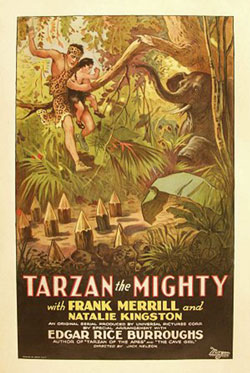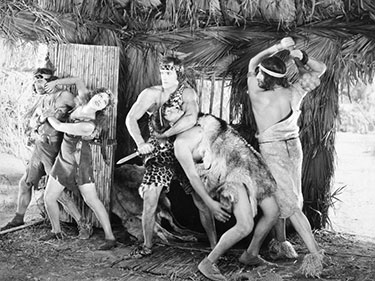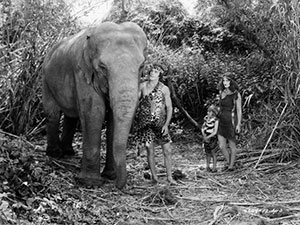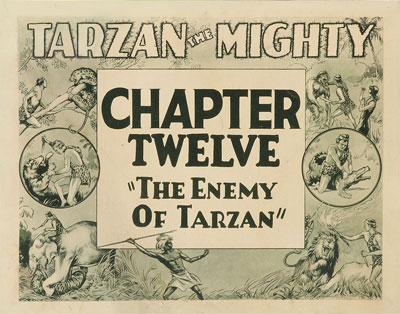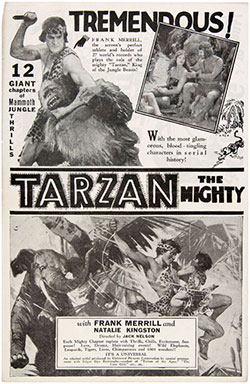T …is for
Tarzan the Mighty
The fifteen-part serial Tarzan the Mighty (1928), produced and released by Universal and directed by Jack Nelson and Ray Taylor, was loosely based on Edgar Rice Burroughs’ popular Jungle Tales of Tarzan. Although the serial was initially planned to be twelve episodes long, the early chapters met with such excitement from moviegoers that it was immediately expanded.
Starring as Tarzan was Frank Merrill, who had doubled for Elmo Lincoln in the feature film Adventures of Tarzan (1921), in which Tarzan, the son of a British lord, had been stranded in the African jungle and raised by apes. When his American friend (and, later, wife) Jane Porter is abducted by slave traders and then kidnapped by Queen La of Opar, he comes to her rescue in dramatic fashion. He also frustrates the scheming William Clayton, who is after his family title.
Merrill was not, however, the first choice for the lead in Tarzan the Mighty. That role was originally offered to John Bonono, who at the time was completing another picture, Perils of the Wild, an adventure serial based on Johann David Wyss’s novel The Swiss Family Robinson.
Tarzan had already been the subject of numerous silent films—among them, Tarzan of the Apes (1918), The Revenge of Tarzan (1920), The Son of Tarzan (1920, serial), Adventure of Tarzan (1921, serial), and Tarzan and the Golden Lion (1927). Over the next decade, even more Tarzan productions were released, among them Tarzan the Ape Man (1932), Tarzan the Fearless (1933, serial), Tarzan and His Mate (1933), The New Adventures of Tarzan (1935, serial), Tarzan Escapes (1936), Tarzan’s Revenge (1938), and Tarzan Finds A Son! (1939). By the 1930s, in fact, jungle films had become a cinematic staple, and audiences flocked to see them, especially the new Tarzan productions. Some film critics, however, found such “notorious ‘Africa’ films” troubling, arguing that they served as a vehicle for perpetuating black stereotypes. As James R. Nesteby observed, the jungle films allowed Americans to “play out formulaic ritual and tensions over and over again to reaffirm the Anglo superiority complex”—nowhere more graphically perhaps than in the 1933 King Kong, now considered by some to be a classic of cinematic folklore and of racist Hollywood filmmaking.
Survival Status: Presumed lost.
Director: Jack Nelson, Ray Taylor
Release Date: October 29, 1928
Release Company: Universal Pictures Corporation
Cast: Frank Merrill (Tarzan), Al Ferguson (Black John), Natalie Kingston (Mary Trevor), Bobby Nelson (Bobby Trevor), Lorimer Johnston (Lord Greystoke).
Episodes: 1. The Terror of Tarzan. 2. The Love Cry. 3. The Call of the Jungle. 4. The Lion’s Leap. 5. Flames of Hate. 6. The Fiery Pit. 7. The Leopard’s Lair. 8. The Jungle Traitor. 9. Lost in the Jungle. 10. Jaws of Death. 11. A Thief in the Night. 12. The Enemy of Tarzan. 13. Perilous Paths. 14. Facing Death. 15. The Reckoning.

